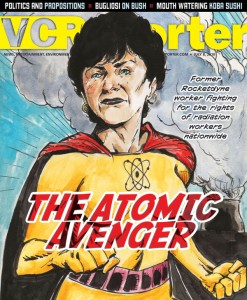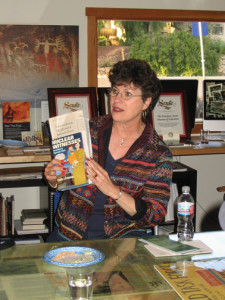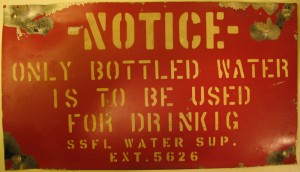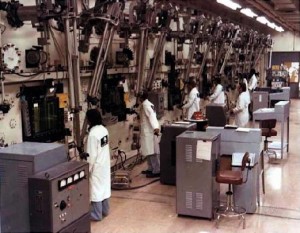 Former Rocketdyne employee and cancer survivor battles for radiation worker compensation
Former Rocketdyne employee and cancer survivor battles for radiation worker compensation
By Michael Collins
Ventura County Reporter – July 8, 2010
The eyes of Bonnie Klea are extraordinarily bright and unblinking. There is no trace of self-pity for her courageous fight against bladder cancer, now in remission, or her years-long battle with Boeing, Rocketdyne and various federal agencies over the rights of other sick radiation workers.
Instead, there is the steady look of someone who has said, “Enough is enough — let me handle this,” and who went and did just that. Hundreds of Ventura County residents and their families will soon know the bounty that Bonnie Klea has secured for them.
“When I was very young, my parents labeled me as stubborn and bull-headed” says Klea. “Now I realize that those characteristics can be an asset when one is seeking justice from the United States government and a large corporation. For 15 years, I have been seeking justice for myself and others.”
Those assets now count in the tens of millions because of new laws that are kicking in over the next few months to compensate ill Cold War Era radiation workers, thanks to Klea. Hundreds of nuke workers are now eligible for the costs of any one or more of 22 ailments associated with radiation exposure, lost wages and a $150,000 lump sum payment, tax free, for the cancer they’ve endured.
The federal monies are a result of the Energy Employees Occupational Illness Compensation Program Act, passed in 2000 by the Clinton Administration. EEOICPA is administered by the National Institute for Occupational Safety and Health, or NIOSH, under the auspices of the Department of Labor.
“Up until this time, the federal government helped the corporations fight all worker claims for radiation exposure illnesses,” says Klea. “I called the Department of Labor immediately to find out which companies were listed. I was shocked to see Atomics International and Rocketdyne listed with work sites at DeSoto, Canoga, Downey and Santa Susana.”
The infamously polluted Santa Susana Field Laboratory, called SSFL but better known as Rocketdyne, is the site of the worst nuclear meltdown in the nation’s history in July 1959. The Sodium Reactor Experiment, or SRE, experienced melting to a third of its core, sending radiation spewing out of the uncontained building above Simi Valley. Quantities of radionuclides escaping the crippled reactor were hundreds of times more than the radiation that escaped at the 1979 Three Mile Island meltdown in Pennsylvania.
For years, Klea has been involved in the fight to have the 2,850-acre east Ventura County lab cleaned up, which is how she came to learn of EEOICPA. In May, Klea became a panel member of the Santa Susana Field Laboratory Workgroup that meets quarterly in Simi Valley under the umbrella of the U.S. Environmental Protection Agency.
Klea will need all her moxie to tackle this new role as a community representative monitoring the cleanup of Rocketdyne that is scheduled for completion in 2017 after costing upward of $1 billion. Lab owner Boeing has sued the state over the cleanup, claiming that the admissible cleanup levels for contamination are too strict.
Workgroup members recently convinced the Los Angeles Regional Water Board not to relax pollution controls for the millions of gallons of effluent with high dioxins, lead and alpha radioactivity that sluice off of Rocketdyne each year. That goo flows through the American Jewish University Brandeis-Bardin Campus into the Arroyo Simi aquifer that provides the eastern part of Simi Valley with drinking water. The toxic slush also flows downhill into the Los Angeles River.
The Workgroup panel itself has come under attack by a combative group of meltdown deniers and self-appointed Rocketdyne experts that complicates the community’s longtime struggle.
 “At the meeting, I did tell the Workgroup [May 12 in Simi Valley] that without them I couldn’t have had the knowledge or known the contacts to go up against the Department of Labor and NIOSH,” says Klea. “I had collected a moving box full of data to submit to the Department of Labor to prove no monitoring, bad monitoring and falsified data. I realized that I was the only worker who could write a Special Exposure Cohort Petition for our workers and without it, no one would get paid. The Workgroup detractors haven’t been attending the meetings for 15 years and haven’t seen what I have seen; and really, they don’t want to know the truth.”
“At the meeting, I did tell the Workgroup [May 12 in Simi Valley] that without them I couldn’t have had the knowledge or known the contacts to go up against the Department of Labor and NIOSH,” says Klea. “I had collected a moving box full of data to submit to the Department of Labor to prove no monitoring, bad monitoring and falsified data. I realized that I was the only worker who could write a Special Exposure Cohort Petition for our workers and without it, no one would get paid. The Workgroup detractors haven’t been attending the meetings for 15 years and haven’t seen what I have seen; and really, they don’t want to know the truth.”
Klea now finds herself in the eye of the Santa Susana Field Laboratory (SSFL) storm, and she wouldn’t have it any other way. After all, she points out, only 148 cases out of 834, or 18 percent, have been paid to the workers of the lab’s Area IV, where the nuclear work took place at the Department of Energy’s ETEC or Energy Technology Engineering Center.
All nuclear employees who worked in the 290-acre area from 1955 to 1964 for at least 250 days and suffer one of the 22 specified cancers are eligible. Klea wants that time frame extended eventually to 1988 and for workers expected to take part in the $1 billion cleanup.
“Downey and Canoga are finished for the [Department of Energy] period — everyone will be paid, and all I have left is DeSoto and SSFL,” Klea says. “I am now working on 1965 to 1970. It is getting harder but I understand that NIOSH has no neutron measurements during that period because the badges did not pick them up. I don’t think NIOSH ever had any records to do dose reconstruction, so I won’t quit.”
This wasn’t the life Bonnie Klea expected when she moved to California in 1962 from a small town in Minnesota after graduating from a business college. After working in the mortgage industry for one year, Klea had the opportunity to interview for a job at SSFL for Atomics International. The Atomic Energy Commission did an extensive background check on Klea and she was hired.
Part of Klea’s job was to drive around and deliver paychecks on Friday to all the workers. The terrain was rugged and the support buildings were all outside of her office space, so she made daily treks to the mail and supply rooms, ditto building and the photo and x-ray labs.
“The mountain was a beautiful place to work,” says Klea. “I did what I was told even though I did not know the nature of the work. I had a ‘Q’ clearance and did not try to understand what was going on for reasons of national security.”
Years later, she would find out what was going on at “The Hill” during the go-go Cold War years of 1963 to 1965 at ETEC. Klea’s daily duties for the Department of Energy took her by 10 experimental nuclear reactors, a “hot lab” for cutting apart radioactive reactor rods brought in from around the country for disposal, and a “sodium burn pit,” where radioactive barrels of sodium were tossed into a gooey toxic muck and shot at to explode the canisters to incinerate the sodium.
Klea was onsite when one of the worst disasters happened at SSFL in 1964, and 80 percent of an experimental space nuclear reactor’s fuel rods cracked, leaking radioactivity into the atmosphere from the unfortified reactor building. A similar disaster occurred again in 1969, with a third of a space reactor’s rods cracking.
The meltdowns have left the groundwater contaminated with radioactive “heavy water” or tritium. Six years ago, the VC Reporter covered revelations that this groundwater was used for drinking at the lab until 1964 (see “In Hot Water,” Sept. 23, 2004). This practice of pumping up the goo for workers to drink took place even though the tritium at that time was estimated to be more than 60 times what is considered harmful by current drinking water standards.
That year, Rocketdyne began supplying workers with bottled water because employees complained of the foul taste and color of the onsite well water that they drank. It is unclear how many workers continued to drink groundwater at SSFL after that, since exclusive use of imported water for drinking only began in the late ’70s, according to Steve Lafflam, former Rocketdyne division director for Safety, Health and Environmental Affairs.
 “Maybe some employees drank it, who knows,” Lafflam said in response to this reporter’s questions at a Department of Energy and Boeing community meeting in 2004. “It’s the way it is. It’s the way we did it in the ’60s.”
“Maybe some employees drank it, who knows,” Lafflam said in response to this reporter’s questions at a Department of Energy and Boeing community meeting in 2004. “It’s the way it is. It’s the way we did it in the ’60s.”
Klea was oblivious to the water she was drinking at the lab, as were most other workers on The Hill. After her two-year Department of Energy stint in Area IV, Klea worked for Rocketdyne in Area I and at the company’s huge Canoga Park plant for six years. She also worked on the DOE’s nuclear program at Rocketdyne’s DeSoto complex in the west San Fernando Valley.
In 1971, Klea and her husband bought a house close to SSFL and started a family. The fulltime mother devoted herself to her two sons, and her years of working close to 10 nuclear reactors were put far into the recesses of her mind. Klea and her husband separated in 1994, and it was during this period that she began having health problems with her bladder.
“By 1994, the pelvic pain was constant and unbearable,” Klea says. “My HMO treated me for bladder infections and menopause for nine months instead of referring me to a urologist to look into the bladder. By 1995, I went into the waiting room in my doctor’s office crying and screaming from the pain for a referral to a urologist. The urologist discovered a 1-centimeter-sized tumor in my bladder. Surgery was required to remove the tumor and to do a pathology test. Alone in the doctors office, I was given the news that I had cancer and had to have my bladder removed or I would die.”
Klea began a medical odyssey that she thought she’d never take since she had been so careful with diet and exercise and had never smoked. Klea decided to fight the cancer aggressively.
“The surgery was extensive and very risky,” Klea says. “I learned that Mayo Clinic did not recommend this surgery for women because our urethra is very short. I consulted with a local oncologist about doing chemotherapy, and he warned me that it was risky to do chemo instead of bladder removal. He also asked me where I worked because bladder cancer is an occupational cancer and quite rare in women. The light went on when I told him that I worked at Atomics International. He said that he was treating many workers from A.I. Previously, he had written a letter to them and asked what they were doing to their workers to cause so many cancers. After weighing all my options and after much prayer, I chose to save my bladder and do chemotherapy followed by radiation.”
Fifteen years later, Klea is cancer free, a “miracle patient” say her doctors. She is also full of fight in her battle to get herself and other atomic workers their fair compensation for their suffering. This struggle seems, at times, harder than beating bladder cancer.
Klea lost her battle for worker’s compensation, in which she says she was threatened by corporate lawyers who blamed her for the illness, claiming that it was household chemicals, airplane flights and drinking sodas that had caused her cancer. She failed in that fight but she learned a lot.
In 2006, Klea started preparing her case for Special Exposure Cohort (SEC) status for SSFL but had to prove to NIOSH that the lab had bad worker radiation monitoring or none at all, and falsified data. Using a box of information collected from 10 years of participation in the Workgroup meetings, she began to piece together a puzzle she found very disturbing, one that included a suspect environmental monitoring program at Rocketdyne where samples were routinely burned in order to lower the radiation values.
“I started rereading everything I had, made notes and did highlighting,” Klea says. “I spent one year reading, copying records and summarizing for NIOSH the reasons why Santa Susana should have the SEC status.”
In May of 2007, NIOSH sent letters to applicants whose claims had been denied about a special meeting to inform them of the SEC program. Klea handed her petition to their representatives at this time and met many claimants and heard their stories of cancer and denial of benefits. Her petition qualified for acceptance later that year and, by 2009, all the workers or their families were paid for 1955 through 1958. NIOSH found that the internal monitoring for Santa Susana was inadequate and because all the facilities used the same monitoring program, Downey, DeSoto and Canoga facilities now have a very good chance of having claims paid, though the vast majority have not been settled.
 “Bonnie, I can’t thank you enough for the work you have done!” wrote Ventura County resident Wendy Carr in an e-mail to Klea on May 21. Carr’s father, Vernon Burgett, was a fireman for six years at SSFL and at Rocketdyne’s Canoga facility for where he earned a commendation for putting out uranium fires. “Today, I feel as if a load of bricks has been lifted off my shoulders. I feel, for the first time in six years, that my dad did not die in vain. Please know that although much of your work will never be appreciated by others, you have changed my family’s life forever!”
“Bonnie, I can’t thank you enough for the work you have done!” wrote Ventura County resident Wendy Carr in an e-mail to Klea on May 21. Carr’s father, Vernon Burgett, was a fireman for six years at SSFL and at Rocketdyne’s Canoga facility for where he earned a commendation for putting out uranium fires. “Today, I feel as if a load of bricks has been lifted off my shoulders. I feel, for the first time in six years, that my dad did not die in vain. Please know that although much of your work will never be appreciated by others, you have changed my family’s life forever!”
SSFL Workgroup co-chair Dan Hirsch of the nuclear watchdog group Committee to Bridge the Gap, praised Klea at a Workgroup meeting in February.
“I think everyone here needs to understand how much you owe to Bonnie, who has been tirelessly trying to defend other former employees who had health problems from their exposures, relatives of people who died,” Hirsch said to the Simi Valley audience. “She has succeeded in getting the federal government to recognize these cohorts, these groups of workers for compensation. The world is held up by people who don’t give up. Bonnie didn’t give up and you have succeeded and you’ve helped a lot of people.”
Unlike Erin Brockovich, the very talented paralegal who helped this reporter when I first started investigating Rocketdyne in 1998, Klea has never had the backup of a law firm. But what she did and does have is the personal power and integrity to get the job done of compensating America’s nuclear workers for injuries suffered in the course of their historic work. It is a job that Klea has clearly relished.
“I now know that when my life is over that I have accomplished my purpose for being here and that there was a reason for going through trials and suffering to see justice for our injured workers and families who were devastated by death and cancer of family members,” Klea says. “I feel victorious and want to continue to help the workers. The feelings for the injured families go very deep into the soul, and the satisfaction of helping them is a quiet, strong satisfaction.”
COMMENT on this article at “Atomic Avenger” post
Cover illustration by Ryan Samuel Carr
27 Years of Award-Winning SSFL/Rocketdyne Reporting
1998 – 2025












Recent Comments